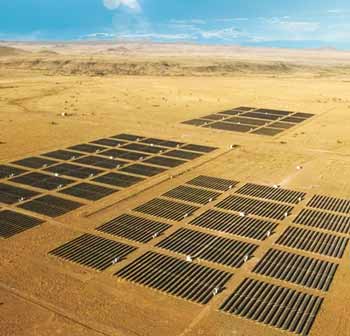On Monday, Commissioners Marc Spitzer, Bill Mundell and Kris Mayes voted
to require regulated electric utilities to generate 15 percent of their
energy from renewable resources by 2025. For 2006, utilities must generate
1.25 percent of retail energy sold from renewable resources.
The Commission's Renewable Energy Standards allow utilities to use solar,
wind, biomass, biogas, geothermal and other similar technologies to
generate "clean" energy to power Arizona's future. The rules package
outlines what technologies qualify and allow for new and emerging
technologies to be added as they become feasible.
In addition to utility-owned projects such as Tucson Electric Power's
large solar installation in Springerville, Arizona, the Commissioners also
required a growing percentage of the total resource portfolio to come from
distributed generation -- residential or non-utility owned installations.
The distributed energy requirement starts at 5 percent of the total
portfolio in 2007 and grows to 30 percent of the total renewable mix after
2011.
In many cases, distributed generation installations -- such as a large
solar installation on the roof of a shopping mall or solar panels at
someone's home -- qualify for utility rebates or state and federal tax
breaks that offset some of the upfront costs.
Unlike other states that set aggressive standards but "grandfather" or
give credit for existing projects, Arizona's Renewable Energy Standards
are focused on adding new generation and taking advantage of emerging
opportunities.
If a utility does not meet the standard, it can apply for a waiver and go
through a hearing but the Commission may still assess a penalty for
noncompliance.
To help offset the increased cost of meeting the more aggressive standard,
the current Environmental Portfolio Surcharge amount will change.
Currently, customers pay $0.000875 per kilowatt-hour. The new surcharge
amount is $0.004988 per kilowatt-hour. There are monthly caps in place to
limit the total impact on customer bills. Currently, residential customers
are capped at 35 cents. The new cap will be $1.05. Nonresidential
customers currently have a cap of $13 but that will increase to a maximum
charge of $39.00. For extremely energy-intensive commercial accounts
(mines, heavy- manufacturing, etc.) the surcharge is capped at $117, up
from $39.
The Renewable Energy Standards were formerly known as the Environmental
Portfolio Standard that topped out at 1.1 percent in 2007. In February
2004, the Commissioners voted to review the rules and consider adopting a
more aggressive standard.
"In 2001, when we passed the current rules we were the first state to do
so," said Commissioner Bill Mundell. "Arizona was on the cutting edge. Now
we've fallen behind. By passing these rules, we've put Arizona back in the
forefront of renewable energy."
The Commission convened a series of intensive workshops involving the
Commissioners and staff, proponents of various technologies, environmental
advocacy groups and the utilities. The Renewable Energy Standards rules
package is the result of this collaborative process.
A recent poll showed that 75 percent of Arizona customers are willing to
pay a little more to ensure our energy independence," said Commissioner
Kris Mayes. "This will reduce the need for additional power plants and
power lines while allowing us to meet the power needs of the thousands of
new people moving into the state each month."
Commissioner Marc Spitzer also joined to support the bill while
Commissioner Mike Gleason voted against it. Chairman Jeff Hatch-Miller was
out of the country on previously planned travel. In a February 16 letter
to his colleagues, Chairman Hatch-Miller signaled his opposition to the
Renewable Energy Standards.
Before taking effect, the rules must go through a review by the Attorney
General's Office and a formal rulemaking process with the Arizona
Secretary of State's office. It could be late in the third quarter or
early in the fourth quarter of 2006 before the regulations are binding.
